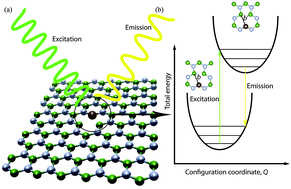First-principles investigation of quantum emission from hBN defects†
Abstract
Hexagonal boron nitride (hBN) has recently emerged as a fascinating platform for room-temperature quantum photonics due to the discovery of robust visible light single-photon emitters. In order to utilize these emitters, it is necessary to have a clear understanding of their atomic structure and the associated excitation processes that give rise to this single photon emission. Here, we performed density-functional theory (DFT) and constrained DFT calculations for a range of hBN point defects in order to identify potential emission candidates. By applying a number of criteria on the electronic structure of the ground state and the atomic structure of the excited states of the considered defects, and then calculating the Huang–Rhys (HR) factor, we found that the CBVN defect, in which a carbon atom substitutes a boron atom and the opposite nitrogen atom is removed, is a potential emission source with a HR factor of 1.66, in good agreement with the experimental HR factor. We calculated the photoluminescence (PL) line shape for this defect and found that it reproduces a number of key features in the experimental PL lineshape.



 Please wait while we load your content...
Please wait while we load your content...